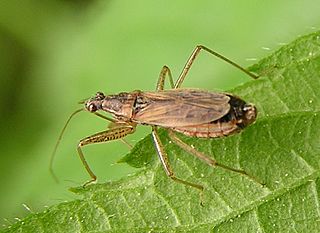
The insect family Nabidae contains the damsel bugs. There are over 500 species in 20 genera. They are soft-bodied, elongate, winged terrestrial predators. Many damsel bugs catch and hold prey with their forelegs, similar to mantids. They are considered helpful species in agriculture because of their predation on many types of crop pests.
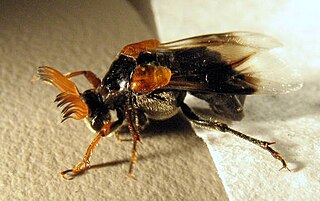
Ripiphoridae is a cosmopolitan family of some 450 described species of beetles sometimes called "wedge-shaped beetles". Ripiphoridae are unusual among beetle families in that many species are hypermetamorphic parasitoids, an attribute that they share with the Meloidae. Members of the family differ in their choice of hosts, but most attack various species of bees or wasps, while some others attack cockroaches or beetles. Many species of Ripiphoridae have abbreviated elytra, and flabellate or pectinate antennae.

Cryptophagidae is a family of beetles with representatives found in all biogeographic realms. Members of this family are commonly called silken fungus beetles and both adults and larvae appear to feed exclusively on fungi although in a wide variety of habitats and situations, such as rotting wood and shed animal fur and feathers. These beetles vary from about 1 to 11 millimeters long, and usually have an oval body shape with a slight "waist".

The Labeninae is a subfamily within the parasitoid wasp family Ichneumonidae. The family is divided into 12 extant genera grouped within four tribes.

The Stenopodainae are a subfamily of Reduviidae. Often cryptically coloured, with prominent mandibular plates, antennal segment 1 generally strongly developed, remaining segments slender and often folded back under the first; hemelytron typically with large pentagonal or hexagonal cell in the corium. Approximately 113 genera are described, with most species found in the tropics. Many species are associated with soil or sand, and many are apterous.

Brachycentridae is a family of humpless casemaker caddisflies in the order Trichoptera. It is found in North America, Europe, and Asia. Georg Ulmer first described it in Germany in 1903 as a subfamily of Sericostomatidae. The type genus for Brachycentridae is Brachycentrus J. Curtis, 1834.

Melanoplini is a tribe of spur-throated grasshoppers in the family Acrididae. There are about 19 genera and more than 200 described species in Melanoplini, all in North America. Their biogeography shows that many species in the tribe have descendants from the Eocene epoch and Miocene epoch.

Toxophorinae is a subfamily of bee flies in the family Bombyliidae. There are about 7 genera and more than 400 described species in Toxophorinae.

Phthiriinae is a subfamily of bee flies in the family Bombyliidae. There are about 11 genera and more than 120 described species in Phthiriinae.
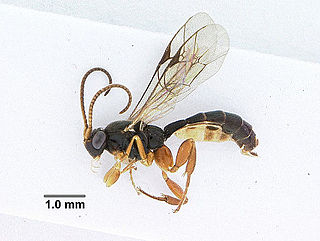
Orthocentrinae is a subfamily of ichneumon wasps in the family Ichneumonidae. There are at least 29 genera in Orthocentrinae.
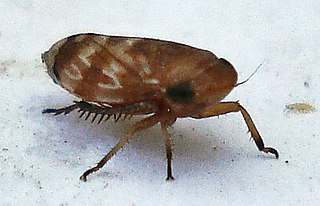
Aphrodinae is a subfamily of leafhoppers in the family Cicadellidae. There are about 7 genera and at least 20 described species in Aphrodinae.

Rhyssinae is a subfamily of parasitoid wasps in the family Ichneumonidae. It contains eight genera and 259 described species, but there are likely many undiscovered species.
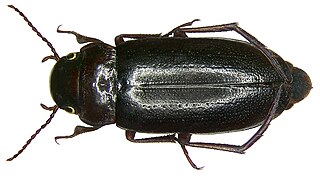
Colymbetinae is a subfamily of predaceous diving beetles in the family Dytiscidae. There are about 11 genera and at least 130 described species in Colymbetinae.

Attagenini is a tribe of carpet beetles in the family Dermestidae. There are at least 4 genera and 20 described species in Attagenini. Attagenini was previously considered a subfamily of Dermestidae called Attageninae, but was reduced in rank to tribe in 2003.

Psocinae is a subfamily of common barklice in the family Psocidae. There are about 11 genera and at least 40 described species in Psocinae.
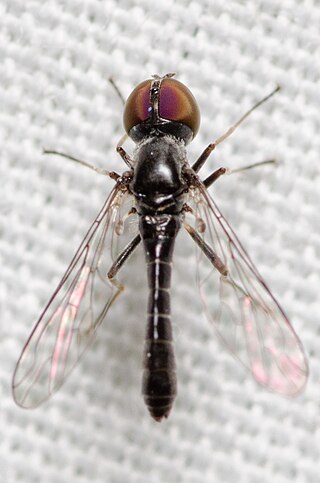
Tomomyzinae is a subfamily of bee flies in the family Bombyliidae. There are at least 6 genera and more than 50 described species in Tomomyzinae.

Batrachideinae is a subfamily of groundhoppers or pygmy grasshoppers. There are thought to be 20 genera in Batrachideinae, with genera found in the Americas, Africa, Asia and Australia.

Brachynomadini is a tribe of cuckoo bees in the family Apidae. There are at least 5 genera and 20 described species in Brachynomadini.
Usiinae is a subfamily of bee flies in the family Bombyliidae. There are at least 3 genera and 180 described species in Usiinae.

Lithurginae is a subfamily of woodborer bees in the family Megachilidae.




















